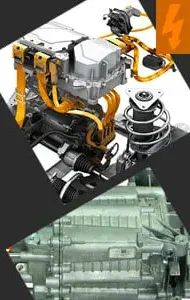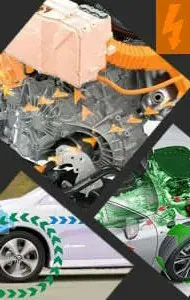Electric Drive Systems

Course Overview
The electric propulsion system is responsible for moving the vehicle using high-voltage current. This assembly of components is called the powertrain and, as it operates with high voltage, it is isolated from the 12 V low-voltage network. Within the powertrain are the electrical energy distribution and supply system, inverter/rectifier, the electric machine and the transmission. The high. voltage battery is not part of the powertrain, as it is a passive element that stores and supplies energy.
The main aims of this course are:
- To identify the components that make up the architecture of the electric vehicle propulsion system.
- To carry out an in-depth study of the electrical and electronic components of the inverter/rectifier module.
- To analyse the different types of electric motors, rotors and stators.
- To understand the operation of the electric motor as a driver and generator.
- To master the processes of maintenance, verification and adjustment of the electric propulsion system components.
- To use different measuring tools that are used on electric vehicles to diagnose faults.
- To carry out the study of an electric vehicle reduction assembly.
- To distinguish between the drive characteristics of an electric vehicle.
- To analyse the operation of the selector lever, both its main operation and parking locking and release, and to understand the control electronics.
- To establish the assembly and maintenance processes of the electric vehicle’s single-gear gearbox.
- To check and carry out the adjustments required of an electric vehicle gearbox.
Course Topics
1.- Architecture of the electric vehicle propulsion system
1.1.- Functions of the powertrain
1.2.- Main characteristics of the electric propulsion
1.3.- Identification of the electric vehicle
1.4.- General architecture of the propulsion system
1.5.- Influence of the electric architecture on the charging options
1.6.- Functions of the batteries in the electrical structure of the propulsion system
1.7.- Test of knowledge
2.- Study of the components of the electric propulsion system
2.1.- Connection, conductor and insulating elements
2.2.- AC/DC charger of the high-voltage battery
2.2.1.- Components and operation of the AC/DC charger
2.3.- Electric converter
2.4.- Inverter/rectifier module
2.4.1.- Components and operation of the inverter/rectifier module
2.5.- Electric machine
2.5.1.- Electric motors as generators
2.6.- Test of knowledge
3.- Maintenance, verification and adjustment of the electric propulsion system components
3.1.- Measuring and control equipment for the electric vehicles
3.2.- Programmed services
3.3.- Electric machine
3.4.- DC/DC converter
3.5.- High-voltage network distributor
3.6.- Insulators, cables and connectors used in electric vehicles
3.7.- High-voltage fuses
3.8.- Low-voltage electrical system
3.9.- Electric propulsion vehicles with extended range
3.10.- Precautions when towing an electric vehicle with a pick-up truck
3.11.- Test of knowledge
4.- Transmission of force in electric vehicles
4.1.- Operating principles of the single-gear gearbox
4.2.- Gear leverBook
4.3.- Establishment of assembly and maintenance processes
4.4.- Verification and adjustment of the systems
4.5.- Test of knowledge
5.- Related videos
5.1.- High-voltage insulationBook
6.- Self-assessment
6.1.- Self-assessment
Average Duration
7 hours 31 minutes
Access This Course
Get access to this course and 30+ more topics by subscribing.
Subscribe to Access All Online Courses
We provide access to all of our online courses for 12 months with a one-time purchase.
£199 ex.VAT per year


